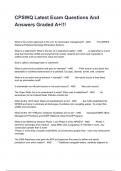CPSWQ Latest Exam Questions And
Answers Graded A+!!!
What is the current approach in the U.S. for stormwater management? - ANS -The NPDES
(National Pollutant Discharge Elimination System)
What is a watershed? What is the size of a watershed called? - ANS -A watershed is a land
area that channels rainfall and snowmelt into creeks, streams and rivers and eventually to
outflow points such as reservoirs, bays and ocean.
Size is called a drainage basin or catchment
What is point source pollution and give an example? - ANS -Point source is any direct and
detectable or confined transmission of a pollutant. Ex) pipe, channel, tunnel, well, container
What is a non-point source pollution + example? - ANS -Non-point source is less direct
such as stormwater runoff.
Is stormwater run-off point source or non-point source? - ANS -Non point source
The Clean Water Act is an amendment to what? When was it established? - ANS An
amendment to the Federal Water Pollution Control Act
What did the 1972 Clean Water Act establish/aim to do? - ANS -the CWA established the
NPDES and aims to eliminate all discharges of pollution into navigable waters. To protect fish,
wildlife and recreation.
What did the 1977 Effluent Limitations Guidelines aim to do? - ANS developed BMPs (Best
Management Practices) and NURP (National Urban Runoff Program)
What is the difference between Phase 1 and Phase 2 of the NPDES? - ANS -Phase 1:
permit for discharges from medium - large MS4s with a population of 100,000 or more. Any
construction greater than 5 acres
-Phase 2: more strict, included small MS4s, all construction greater than 1 acre now need permit
coverage
The 2006 Rapanose case gave the EPA and agencies the power to define and assert
jurisdiction over which waters? - ANS - Traditional navigable waters, wetlands adjacent to
, trad navigable waters, non-navigable tributaries of traditional navigable waters that have at least
continuous flow seasonally, wetlands that directly run alongside the tributaries mentioned before
The EPA will NOT assert jurisdiction over what? - ANS Swales and erosional features with
low volume, ditches (including roadside ditches) UNLESS there is a significant analysis that it is
next to or may affect a navigable water downstream!
What are the three types of Physical pollutants? - ANS -sediment, temperature, gross
solids
Name one source and one impact of sediment pollutants. - ANS -sources: construction
sites, streambank erosion, agriculture
-impacts: reduces light transmission, smothers fish habitat, transports pollutants, affects
recreation(muddy water)
Name one source and one impact of thermal pollutants. - ANS -sources: power plants,
industrial sites, removal of trees (hot rip-rap)
-impacts: threat to fish and aquatic insects, affects the chemistry/rate of other pollutants
What are examples of Chemical pollutants? - ANS -Nutrients (Nitrogen and Phosphorus),
Metals, Hydrocarbons (oils and fuels), Salts, Organic Compounds (paint thinners, solvents,
degreasing and curing agents, Pesticides
-Biological pollutants = bacteria and viruses
-Oxygen Demands = hypoxic, anoxic conditions
Name one source and one impact of nutrient pollutants - ANS -source:
agriculture/landscaping - fertilizer, atmospheric deposition, septic or sewer leaks
-impact: algae blooms (hypoxia), eutrophication, methemoglobinemia (nitrate only)
Name one source and one impact of metal pollutants (copper, zinc, lead, cadmium, iron) - ANS
-sources: roads, building materials, industrial activities, atmospheric deposition
-impacts: toxic to aquatic life, bioaccumulation, threat to human health (ex. Mercury in fish)
Name one source and one impact of hydrocarbon pollutants. - ANS -sources: roads,
fueling sites, emissions, illegal dumping, vehicle and equipment leaks
-impacts: threat to aquatic life, threat to human life




